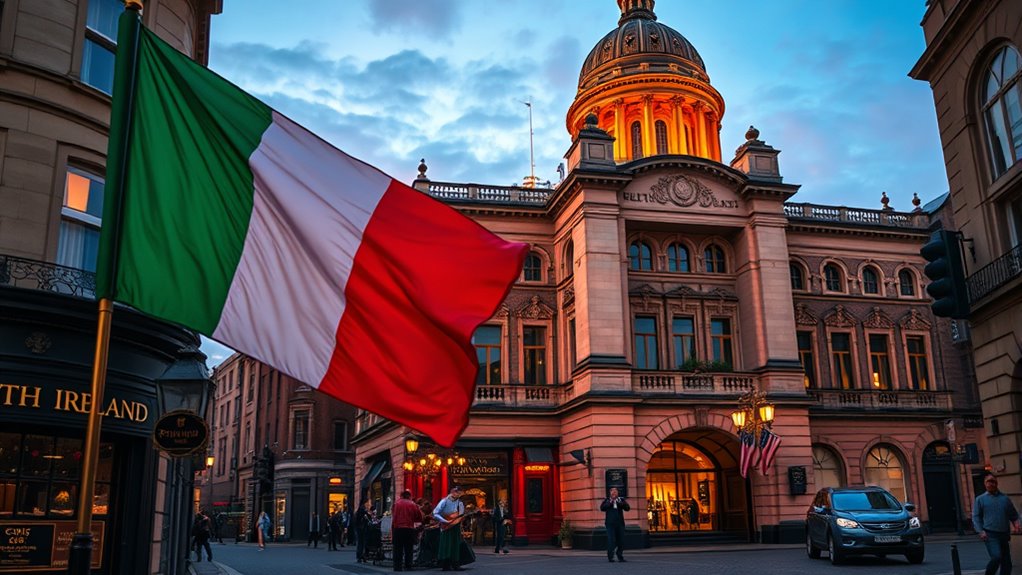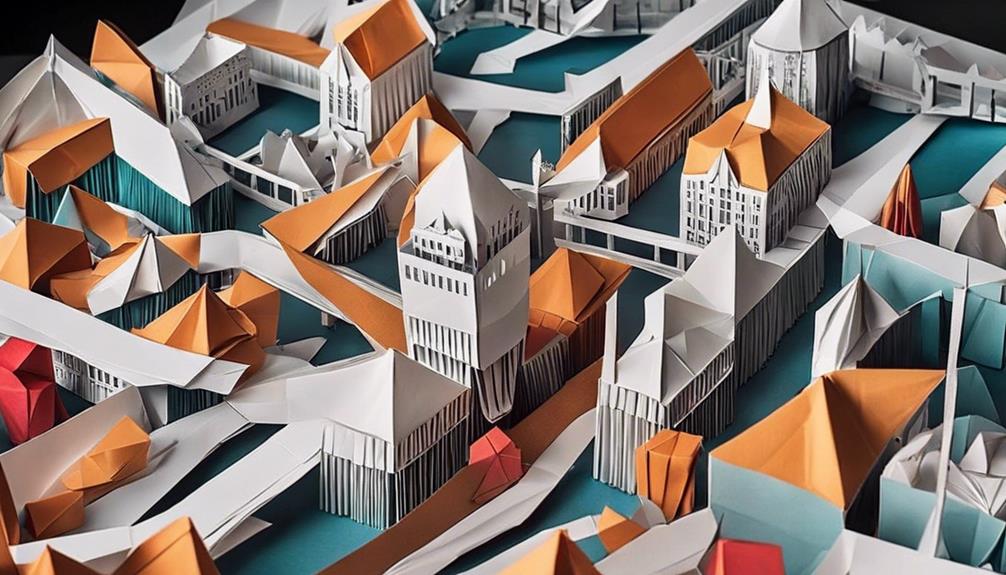Northern Ireland’s history is shaped by partition in 1921, which created a society divided between unionists and nationalists. You’ll find a legacy of conflict, including the Troubles, that lasted over three decades and involved violence, protests, and peace efforts like the 1998 Belfast Agreement. Its culture features symbols like flags, parades, and traditions—highlighting identities rooted in Irish and British heritage. Exploring further reveals the deep roots of societal divisions and cultural expressions that still influence today’s society.
Key Takeaways
- Northern Ireland was established in 1921 through the Government of Ireland Act, creating a unionist-majority entity with a complex history of conflict and peace efforts.
- The Troubles (1960s–1998) involved violent sectarian conflict between unionists and nationalists, deeply shaping societal divisions and cultural identities.
- Symbols like flags, parades, and emblems reflect longstanding cultural and political allegiances, often sparking community tensions and debates.
- Cultural traditions include Gaelic games, Irish language, and Ulster Scots influences, emphasizing both Irish and British heritage.
- Contemporary society promotes reconciliation through community events, murals, integrated schools, and shared cultural expressions, fostering peace and diversity.
The Origins of Partition and the Creation of Northern Ireland

Have you ever wondered how Northern Ireland came to be a separate entity within Ireland? It all started with the Government of Ireland Act 1920, which divided the island into two distinct parts. On May 3, 1921, Northern Ireland was officially established as a separate legal entity, consisting of six counties: Antrim, Armagh, Down, Londonderry, Fermanagh, and Tyrone. The decision reflected the majority unionist population in the northeast, who supported remaining part of Britain, versus the nationalist majority in the west, who opposed partition. This act created an autonomous government with devolved powers from Westminster, setting the stage for decades of political and social tensions that would shape Northern Ireland’s future. The High Court of Justice was also established to oversee legal matters within Northern Ireland, further defining its governmental structure.
Political Developments and the Struggle for Power
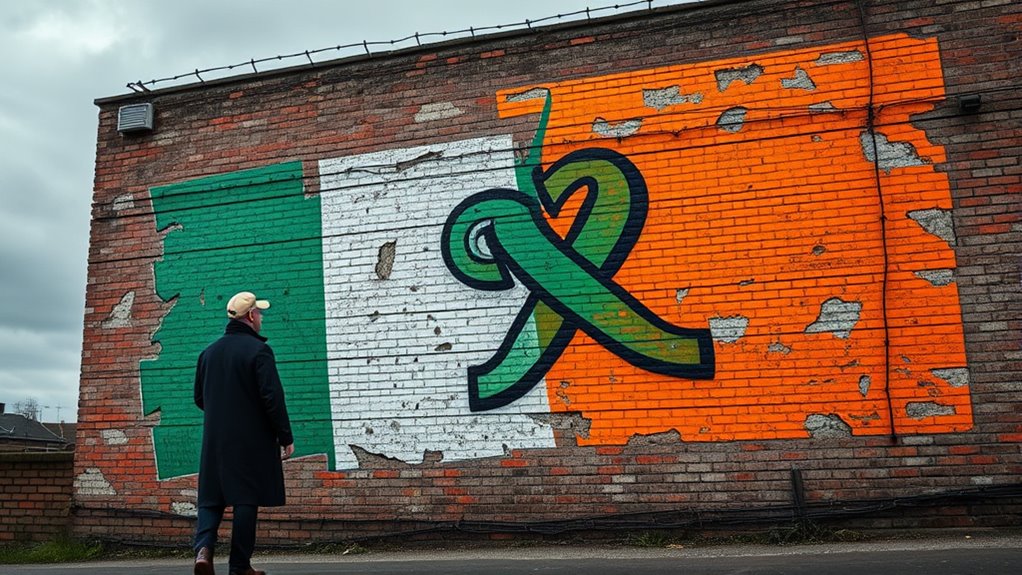
You see how partition shaped Northern Ireland’s governance, creating a separate legal entity with a dominant unionist control. Over time, political parties like the Ulster Unionists and later the DUP and Sinn Féin have fought for power, often leading to instability. The peace process, marked by key agreements, has aimed to balance power-sharing and reduce tensions, but political struggles continue today.
Partition and Governance Changes
The political landscape of Northern Ireland has been shaped by a series of pivotal changes in governance and power dynamics, starting with the 1920 Government of Ireland Act that partitioned the island and established Northern Ireland as a separate legal entity in 1921. You witness how this division created a fragile balance of power, with unionists holding dominance through the Ulster Unionist Party until 1972. The governance structure faced constant tension, marked by discrimination, conflict, and attempts at reform. Despite efforts like the 1998 Belfast Agreement to share power, disagreements persist. The table below captures the emotional stakes of these shifts:
| Hope | Conflict | Change |
|---|---|---|
| Unity among communities | Violence and division | Struggle for peace |
| Equality in governance | Discrimination and unrest | Evolving power-sharing |
Furthermore, the ongoing challenges in maintaining power-sharing arrangements reflect the complex history of governance and cultural identities in the region.
Peace Process and Agreements
Since the signing of the 1998 Belfast Agreement, Northern Ireland has experienced a significant shift towards political stability through power-sharing arrangements. You witness a fragile peace taking hold, marked by ongoing negotiations and efforts to maintain harmony. Tensions still surface, but dialogue and compromise drive progress. You imagine:
- Leaders shaking hands at historic talks, signaling hope.
- Ceasefires holding despite sporadic violence.
- Communities slowly rebuilding trust through joint initiatives.
- Symbols of division giving way to shared celebrations.
- Politicians navigating complex agreements to keep peace.
This process remains delicate, with occasional setbacks. Yet, your awareness grows of a society striving to reconcile differences and forge a collective future, emphasizing cooperation over conflict amid enduring divisions. The presence of resources and tools such as community programs and legal frameworks supports ongoing peacebuilding efforts.
Political Party Dynamics
Political party dynamics in Northern Ireland have long shaped its governance and stability, with power often shifting between unionist and nationalist parties. You’ll see that the Ulster Unionist Party dominated from 1921 until 1972, defending union with Britain. Meanwhile, nationalist parties like Sinn Féin and the Social Democratic and Labour Party (SDLP) pushed for Irish unity. The Troubles intensified these divisions, leading to frequent government suspensions. Since the 1998 Belfast Agreement, power-sharing became central, forcing unions and nationalists to cooperate. Recent years have seen fluctuating support, protests, and disagreements over issues like identity and culture. You’ll notice that party alliances and rivalries continue to influence policy, peace efforts, and societal cohesion, reflecting Northern Ireland’s ongoing struggle to balance its complex political landscape.
The Troubles: Conflict and Peacebuilding
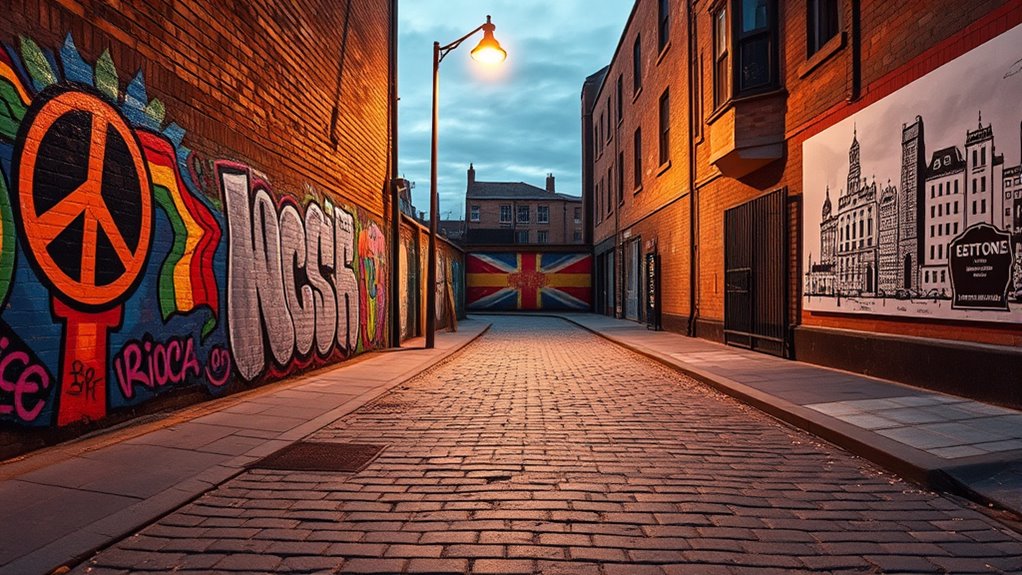
Amid escalating tensions in the late 1960s, Northern Ireland plunged into a violent conflict known as The Troubles, which lasted for over three decades. You witness bombings, shootings, and street clashes that tear communities apart. The streets fill with protests, parades, and confrontations between factions. You see:
- Barricades and soldiers patrolling neighborhoods
- Murals depicting political symbols and allegiances
- Peace walls dividing Catholic and Protestant areas
- Mourning families at funerals and memorials
- Large-scale protests demanding justice and recognition
During this dark period, violence claimed over 3,500 lives, and many more suffered injuries. The conflict’s toll fostered deep mistrust, but eventually, peace efforts and the 1998 Belfast Agreement started healing wounds and building hope. Peacebuilding processes played a crucial role in moving past cycles of violence toward reconciliation and stability.
Cultural Identity and Symbols of Division
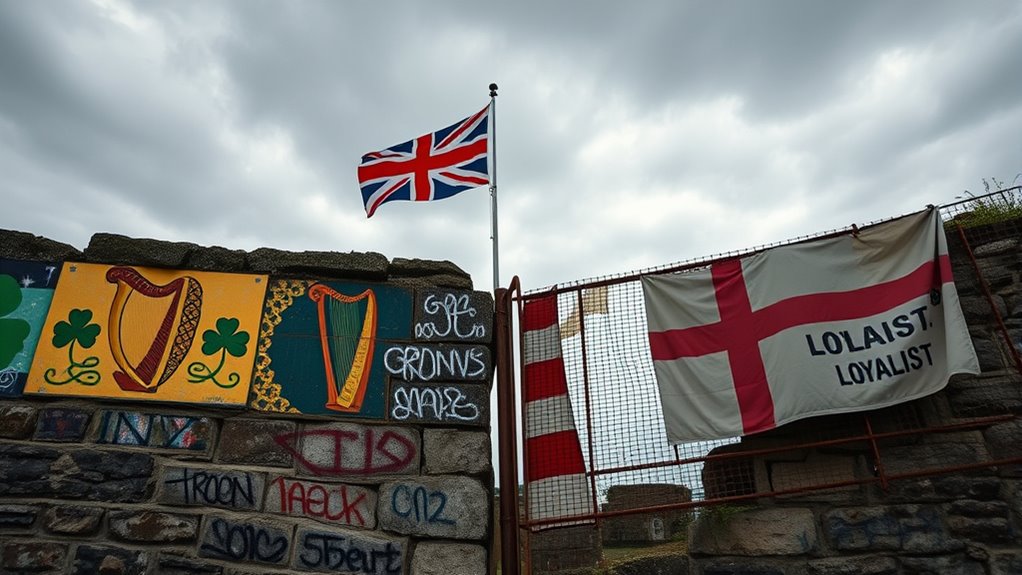
Flags and emblems are powerful symbols that represent different identities in Northern Ireland, often sparking debate and tension. Parades and celebrations serve as expressions of community pride but can also highlight divisions between groups. These symbols shape perceptions and reinforce the deep-rooted cultural divides in the region.
Flags and Emblems
Symbols like flags and emblems serve as powerful markers of identity in Northern Ireland, often reflecting deep-rooted divisions. You see the Union Jack flying proudly in unionist areas, symbolizing allegiance to Britain. In contrast, the Irish tricolor waves in nationalist communities, representing Irish heritage and independence. Emblems like the Ulster Banner are displayed in Northern Ireland’s sports events, signifying regional pride. The Orange Order’s flags, with their orange sashes and symbols, evoke Protestant history and tradition. Meanwhile, Catholic communities might display emblems honoring Irish saints or historical figures. These symbols often spark intense reactions, highlighting the ongoing cultural divide. You can witness these emblems during marches, in homes, or at public events, serving as constant reminders of identity, loyalty, and historical conflict. Additionally, the influence of cultural heritage tied to natural surroundings can be seen in various symbolic representations and traditional practices associated with the different communities.
Parades and Celebrations
Parades and celebrations in Northern Ireland vividly showcase the island’s deep-rooted cultural divisions. You’ll notice that Orange Order marches, which celebrate Protestant heritage, often pass through nationalist neighborhoods, sparking tensions. Conversely, nationalist parades, like Irish cultural festivals, emphasize Irish identity and pride. These events are more than festivities—they symbolize historical claims, religious loyalties, and political allegiances. You might see flags, symbols, and chants that reflect community histories and identities, often igniting debates about their appropriateness. While some view these parades as expressions of culture, others see them as provocations. Despite efforts to promote shared celebrations, these events remain highly contentious, embodying the ongoing struggle to reconcile Northern Ireland’s divided identity through public displays of cultural and political symbolism. The significance of these events is often amplified by their political implications, which continue to influence community relations.
Historical Events Shaping Society and Demographics
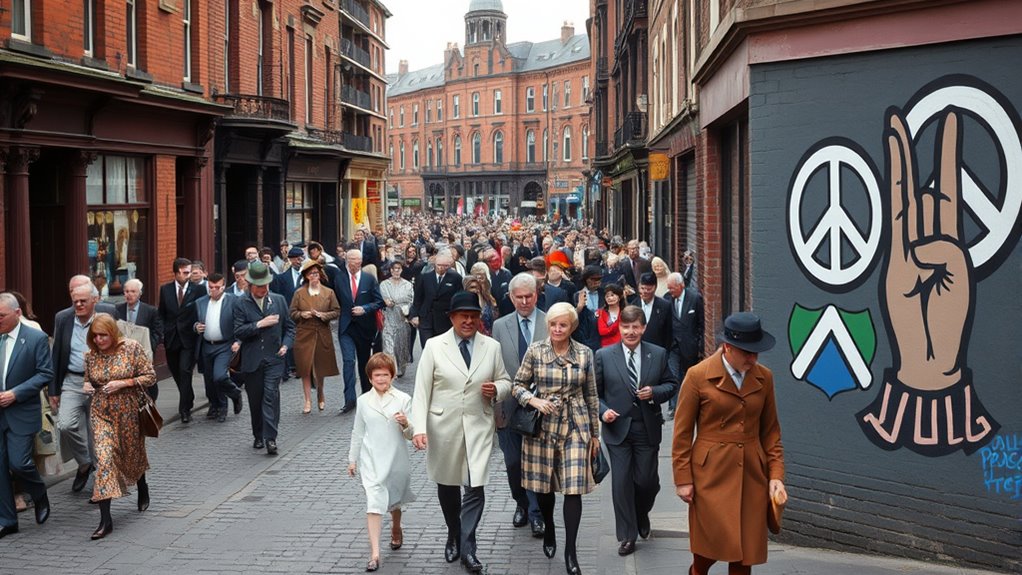
The history of Ireland, particularly the events surrounding the plantation of Ulster in the 1600s and the Irish Famine of the mid-19th century, has profoundly shaped the society and demographics of Northern Ireland. You can picture the scars of colonization, where Protestant settlers established communities amid a Catholic population. The Irish Famine led to mass emigration, especially among Catholics seeking better lives abroad. The partition of 1921 created a divided society, with unionist strongholds in the northeast and nationalist areas in the west. Over time, political conflicts, including The Troubles, caused deep divisions and violence. Today, these events leave a legacy of shared yet conflicted identities, influencing societal structures, community relations, and ongoing debates about culture and sovereignty.
- Colonization and settlement patterns
- Mass emigration during famine
- Partition creating societal divides
- Violent conflicts like The Troubles
- Legacy of shared identities amidst division
Language, Traditions, and Cultural Expressions

The complex history of Northern Ireland shapes its vibrant cultural expressions and linguistic landscape today. You’ll notice a rich mix of traditions reflecting both unionist and nationalist identities. Gaelic games like hurling and Gaelic football celebrate Irish heritage, while Ulster Scots influence local music and storytelling. Languages such as Irish and Ulster Scots are recognized symbols of cultural pride, though Irish remains a subject of debate. You’ll see colorful festivals, marches, and religious ceremonies that express community identity. Traditional music blends folk tunes with contemporary styles, often performed at local pubs and events. Artistic expressions through literature, dance, and visual arts also reflect the region’s divided yet interconnected identities. These cultural elements serve as essential links to the past and expressions of regional pride today. Additionally, the cultural diversity of Northern Ireland is reflected in its wide range of festivals and community celebrations that honor various heritages.
Contemporary Society and Evolving Identities
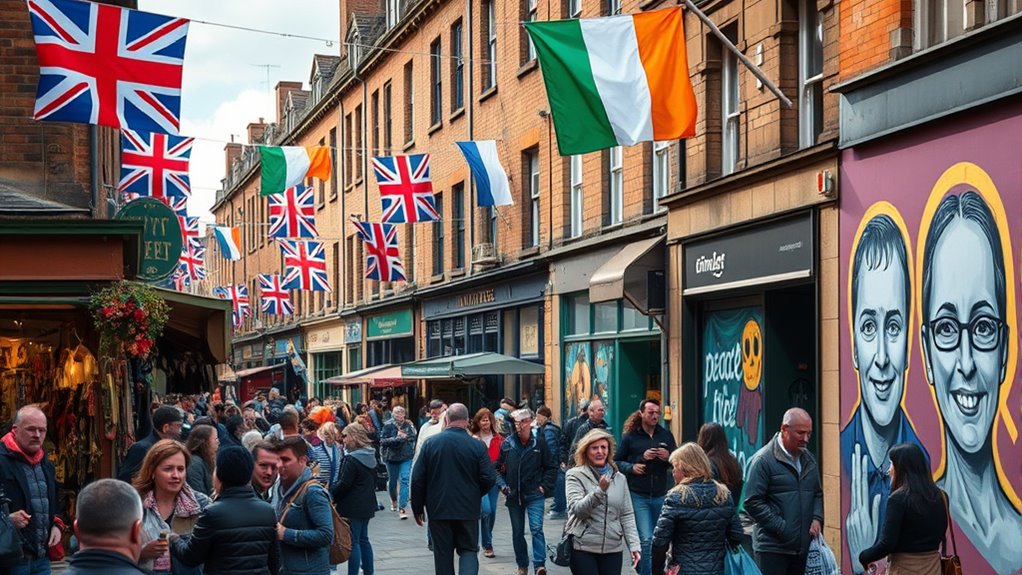
How has Northern Ireland’s society evolved in recent years as communities navigate their complex identities? You see a society gradually shifting toward understanding and coexistence. More people embrace multiple identities, blending Irish and British loyalties. Young generations challenge traditional divisions through cultural expression and dialogue. The landscape is filled with symbols that reflect this change—flags flown side by side, diverse festivals celebrating shared heritage, and educational efforts promoting inclusion. Additionally, the influence of cultural and artistic significance in shaping collective memory and community identity is increasingly evident through public art and celebrations.
Northern Ireland’s society embraces shared identities, fostering understanding, cultural expression, and peaceful coexistence.
- Vibrant murals depicting peace and unity
- Community events bridging divides
- Young activists advocating reconciliation
- Art and music blending Irish and British influences
- Schools fostering integrated, mixed-religion environments
Frequently Asked Questions
How Has Northern Ireland’s Economy Evolved Post-Conflict?
Since the conflict ended, you’ll notice Northern Ireland’s economy has shifted toward services, technology, and tourism, reducing reliance on traditional industries like shipbuilding and manufacturing. Investments in infrastructure and education boost innovation and attract businesses. You’ll find growth in financial services and creative sectors, creating jobs and opportunities. Although challenges remain, especially in areas still recovering from past unrest, the economy is steadily diversifying and aiming for sustainable development.
What Role Do Sports and Music Play in Community Identity?
You might be surprised how sports and music become powerful tools to bridge divides and build community. In Northern Ireland, they ignite pride and unity, offering a shared space amid persistent tensions. You can see it in passionate football matches or vibrant music festivals that bring diverse groups together. These cultural expressions challenge stereotypes, foster understanding, and remind everyone that even in divided times, common passions can unite and inspire hope for a better future.
How Do Religious Communities Collaborate in Modern Society?
You see that in modern society, religious communities work together through dialogue, shared projects, and community initiatives. They prioritize peacebuilding, mutual understanding, and social cohesion, often participating in interfaith events and collaborations. Despite historical divisions, many actively promote reconciliation, respect diverse traditions, and support local causes. Your involvement or support in these efforts helps foster harmony, breaking down barriers and strengthening relationships across religious and community lines.
What Is the Significance of the Irish Language Today?
The Irish language is a living river flowing through Northern Ireland’s identity, connecting past and present. Today, it symbolizes cultural resilience and pride for many, with government efforts promoting its use in schools and media. You can see its ripple effect in festivals, signage, and community groups endeavoring to keep it alive. While not everyone speaks it daily, its significance lies in preserving a unique voice amid a tapestry of diverse identities.
How Do Younger Generations View Their National Identity?
You see that younger generations in Northern Ireland have more diverse views on their identity. Many embrace a shared, inclusive sense of community, regardless of traditional divisions. Some identify strongly as Irish or British, while others prefer a neutral or dual identity. You notice increasing cultural expressions, like music and arts, that reflect this complexity. Overall, younger people are shaping a more open, flexible understanding of who they are, moving beyond old divides.
Conclusion
As you explore Northern Ireland’s rich history, remember it’s a tapestry woven with resilience and hope. Like a phoenix rising from the ashes, its culture and people continue to evolve, blending old traditions with new dreams. Though shadows of conflict linger, the spirit of peace and unity shines brighter every day. Embrace this journey, for in understanding its past, you hold the key to shaping its future—a story still being written.

